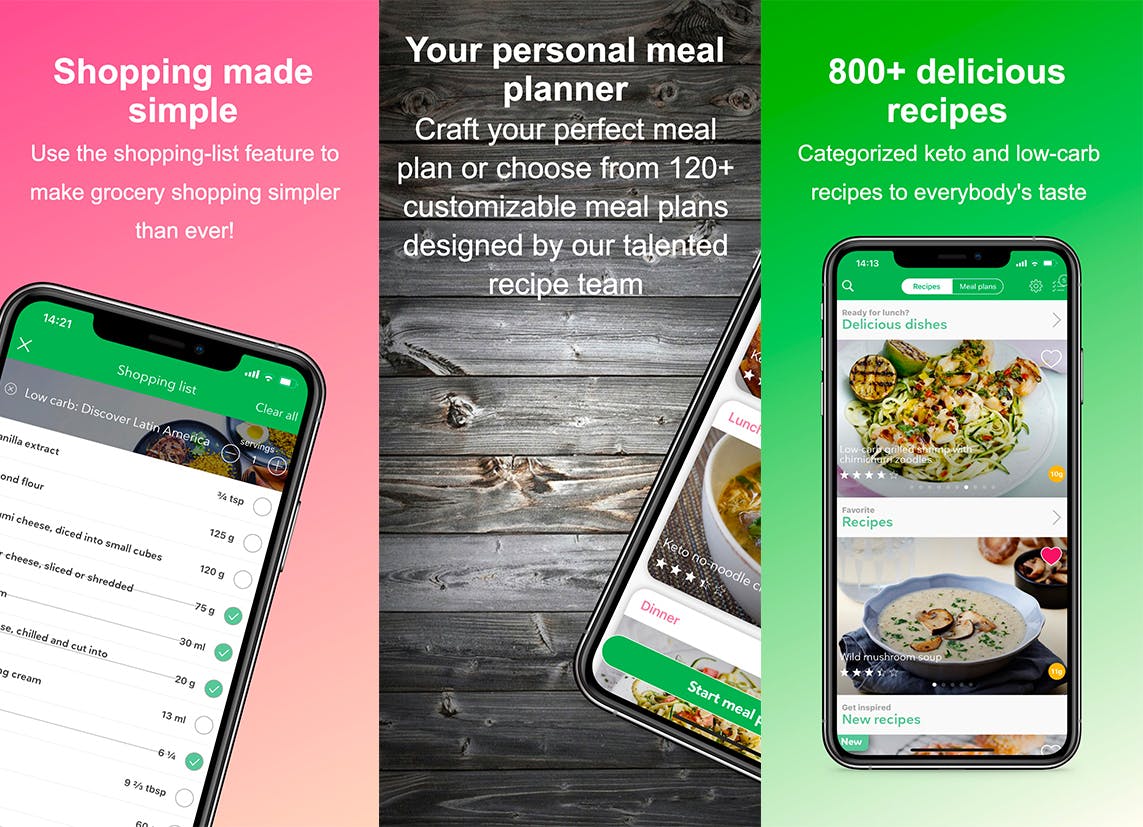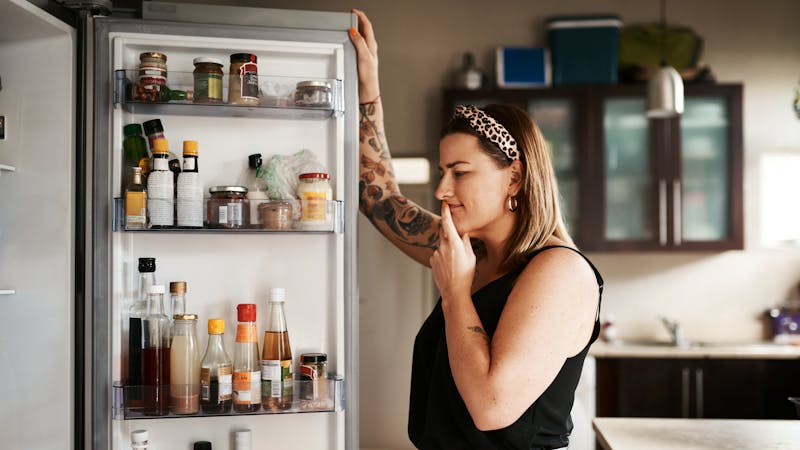Cooking low carb during a coronavirus quarantine
Preparing low-carb or keto food at home each night is a new reality for many of us. How can you make it easy and enjoyable?
This guide will help you manage your kitchen under unusual circumstances. We’ll offer practical advice and some tips to make it fun rather than overwhelming, too.
Whatever challenge the COVID-19 pandemic brings — missing ingredients, carb-eating houseguests, lack of fresh food, or a tighter budget — here’s how to make it work.
1. How to cook every day
For most of us, cooking is a part of our routine, but so is eating out. How will you get through the coming weeks if eating in restaurants or ordering takeout isn’t an option?
Explore online recipes
If you’re home all day, you may have more time to explore recipes and experiment with new dishes. Our recipe collection has so much to offer — over 900 low-carb and keto recipes. Either scroll through some of the recipe carousels on the main page, or check out one of our dozens of recipe collections.
You can use our advanced search function if you prefer; choose the type of meal, main ingredient, level of carbs, and let our site offer up all of the options that match your needs.
One of the best ways to try lots of new recipes is with our meal plans. These plans can be customized, and come with an automated shopping list. The list gets you organized to buy a whole week’s worth of groceries with just one trip to the store.
Our recipe app for iPhone, Diet Doctor Eat, is another great way to cruise through our recipes. The mobile-friendly format puts our entire collection at your fingertips, stove-side. And with Diet Doctor Plus, you’ll be able to get customized grocery lists right on your phone.
Or, if you use an Android smartphone, an early version of our Android app is now available. We need lots of users to test its stability and performance. If you would like to be a “beta tester” click on this link. There, you will be asked to register. Then just follow the instructions that will be sent to your inbox. Play with the app. Search recipes. Select some tags and complete recipe steps. If something looks slow or broken, send a report to our Android developer Stas Shakirov at stas.shakirov+app@dietdoctor.com.

Diet Doctor Eat — Try our amazing keto recipe app
What’s the best keto recipe app for iPhone? Diet Doctor Eat! Download for free, and enjoy our entire recipe collection in a beautiful and easy phone-friendly format.
Mix it up
Your routine at home doesn’t have to be boring. Set an intention to vary your cooking.
Our site has great options for different types of cuisine: Asian, French, Indian, Mediterranean, Mexican and more. Even Scandinavian! To scroll through all of these options, check out our recipe collection, Low carb and keto around the world.
Another way to mix it up is with effort level. One night, throw together a quick no-cook meal like this tuna plate. The next night, up your game with a dinner that requires some time in the kitchen. Maybe this creamy cauliflower and mushroom risotto sounds delicious?
Consider clean-up in your time calculations, too.
Manage grocery shopping differently
As we try to maintain greater social distancing, grocery shopping is one of the few remaining errands we’re permitted to run. But shopping in larger quantities to minimize trips to the store is advised.
Meal planning and grocery lists help make this even easier. Our meal plans and customized grocery lists are perfect for this sort of shopping. We put all the ingredients you need for a week of low-carb dishes together, organized by area of the grocery store. Or, if you’re a member, use our app and enjoy grocery lists at your fingertips.
When you’re purchasing fresh vegetables with longer intervals between trips to the store, remember that some veggies last longer than others. For more on this, check out the tips in our Ultimate stay-at-home low-carb cooking and baking collection.
For a list of pandemic-friendly items for fridge, freezer, and pantry, check out our post, Six tips for low-carb COVID-19 preparedness.
If you can order groceries online, it’s a nice way to get what you need without leaving the house. For those harder-to-find low-carb favorites, we have a guide with links to common items, all available on Amazon.
Substitutes for missing ingredients
If you are making a recipe but do not have all of the ingredients, remember that it’s okay to substitute. If you keep the substitution low carb and try to stay within the same general food category, it should be fine.
For example, you can swap any protein for a different protein. (Replace chicken with beef or seafood with chicken.) Or swap any cheese for a different cheese that you have on hand.
Nutritionally, veggies are pretty interchangeable as long as they are low carb. Trust yourself. If the substitution sounds good to you, go for it.
As always, fats can be varied. Butter swaps well with ghee and coconut oil, or even lard. Olive oil can work in almost any setting, except very high-temperature frying. Nut oils and avocado oil are also versatile.
Don’t sweat the small stuff. Whatever you have should work.
Share the load
Daily cooking and clean-up are chores. Don’t be shy about asking for help.
School-aged children and teens are incredibly capable and underutilized. They can set the table, prep food, wash dishes, empty dishwashers, and even manage basic cooking.
Although they may initially protest, helping makes kids feel needed, useful, and independent. Don’t be shy. (If you doubt your child’s capacity for household tasks, check out this popular age-appropriate chore chart.)
Partners, roommates, and elders are often more than willing to help when asked. So ask — before you get overwhelmed.
Sometimes it helps to divide and conquer: you cook, someone else does the dishes. For others, taking turns with the cooking every other night is more fun.
Either way, encourage involvement and try not to micromanage. When you ask for help, the carrots might not get sliced the way you would do it. And that’s okay.
Celebrate togetherness
How can you add variety and fun to your mealtime routine? Set out your fancy dishes and glassware. Light the candles. Use a tablecloth.
Dust off the finery you usually reserve for company to celebrate your unexpected time together. You can do this for a spring birthday, or do it every Sunday night. It’s inexpensive (assuming you don’t break anything).
If you invest some extra time in setting the table and hand washing delicate glassware, you can transform yet another night at home into something special. The meal can be on the fancier side — or not. It doesn’t really matter when you celebrate with family.
What about table games? You bet! Do you have any favors left over from a Christmas or New Year’s celebration? Break them out.
Play music and start a sing-along. Hold a talent show around the table. Ask everyone to tell a joke or read something funny. Make the evening count.
In other words, embrace the moment. Make the COVID-19 quarantine work to your advantage, at least for an hour or two.
2. Sharing a kitchen: feeding both keto and conventional eaters
Coronavirus quarantines will bring many families back together under the same roof. Some college students and young adults will move back home. Some older adults may move into a child’s home to avoid isolation.
This coming together of typically separate households can give us an unexpected and (hopefully) welcome time of togetherness. It may also bring a diversity of preferences into your kitchen.
Accommodating guests who eat high-carb meals
If you’re used to a “keto-only” kitchen, adjusting meals so that they suit every eater can be tricky. Here are two key ideas to help you navigate your new, blended kitchen.
Keep temptation low
Ask your “carbivore” housemate to keep the most tempting off-plan foods out of sight. If there are shelf-stable packaged foods, they can be kept in your guest’s bedroom. For refrigerated items, they can be placed in a paper bag or cardboard box in one area of the fridge. Out of sight, out of mind.
Remember, not all carbs are equally tempting for most people.
If you aren’t at all tempted by store-bought cookies, perhaps that is something that you can stock in your cupboards for your guests. Or, if you don’t like pasta anymore, that can be the perfect thing to keep on-hand as a side dish for someone used to eating carbs at each meal.
Sometimes, keeping food in the freezer makes it less tempting; there’s an extra step to keep you from easily popping it into your mouth. Bread, candy, and cookies can all be frozen. It not only makes them less appetizing (until thawed), it keeps them fresh so they can be eaten slowly over time by just the carb-eating members of your household.
Carbs to go with low-carb meals
The best way to keep everyone happy in these situations is to cook a low-carb meal that’s satisfying on its own, and offer an optional side for those who want carbs.
This can be as simple as making hamburgers with a salad and defrosting a couple of hamburger buns for those who want them. Putting together a low-carb casserole and offering rice or potatoes on the side to others, is another example.
Keep it simple and, again, not too tempting. Frozen bread is really easy. Also, microwaving single-serve, packaged mashed potatoes, stuffing, or macaroni and cheese saves you from the work of cooking these starchy sides from scratch. Rice comes in single-serve, pre-cooked packages, too. Or save money by cooking a batch, dividing into single servings, and freezing.
Surviving in a high-carb kitchen
If you find yourself embedded in a high-carb home during the coronavirus outbreak, it can be even trickier. An honest, upfront conversation with your host is a good first step.
Getting permission to do some of your own grocery shopping and storing some low-carb basics in the fridge and pantry will be essential. A key to success will be to have enough low-carb food on hand so hunger does not drive you to eat off-plan items because you have no other options.
For more tips, see our guide to Living low carb in a high-carb world.
3. Cooking when fresh food is limited
When you’re trying to limit exposure to others in the community due to COVID-19 outbreaks in your area, you may need to rely more on canned and frozen items. While they might not seem optimal, they can still make delicious, nourishing meals and keep carb counts low.
Using canned meats
The two most popular canned meats are ham and chicken. They’re on most grocery store shelves. You can also find low-carb versions of canned luncheon meat and sausages.
These meats may have some ingredients that you might want to limit under normal conditions, but these aren’t normal conditions. “Mystery meat” is still meat and can provide an inexpensive and easily stored alternative to fresh products.
Canned meats – mystery or otherwise – make excellent fillings for lettuce wraps or proteins to add to salads or stir-fries. Whip up a flavorful dressing – garlic or sriracha mayo for your lettuce wrap, a homemade vinaigrette for salad – to add some zest to what could otherwise be a ho-hum meal.
Adding canned meats to a creamy, cheesy sauce stretches the protein out. Serve over mashed cauliflower (which works great with frozen cauliflower) to make a comforting meal when everyone is a little more stressed than usual.
You can add one or more of these “extras” to your cream sauce for color, flavor, and nutrition: sautéed onions, garlic, or peppers; mushrooms (canned is fine; drain first); and spinach (frozen is fine; squeeze out the extra moisture first). A dab of mustard and a few pinches of dried oregano or basil make this homey dish a little more special. A sprinkle of red pepper flakes adds spice.
If you find the idea of eating canned meats a little boring, remember that spices and melted cheese can turn even canned meats into a lively dish. Warm up your meat in a pan, sprinkle on some cheese, let the cheese melt, and transfer it all to a plate. Garnish this meaty-cheesy goodness with low-carb salsa, sliced jalapenos from a jar, plus whatever else you like, and you’ll forget about its canned origins altogether.
Using canned fish and canned seafood
Some people, for either taste or religious reasons, don’t eat fish or seafood. But if aversions or beliefs are no obstacle to you and your family, these canned products are your friend. They’re a great way to get nutritious protein and healthy omega-3 fat, as well as trace minerals like zinc, copper, and selenium. Plus they’re relatively cheap and last for more than three years on the shelf.
We are not just talking tinned tuna and salmon. Other canned fish and seafood products to consider include:
- anchovies
- clams and clam juice
- herring
- mackerel
- crabmeat
- sardines
- shrimp
- smoked oysters or smoked mussels
- squid
Many people think of eating these items on their own or as part of a salad plate. But perhaps the most popular presentation is tuna or salmon salad, made by adding diced onion and celery and mixing with either mayo or a vinaigrette.
Here are a few other ideas:
- Make fish cakes or fish fritters. Diet Doctor has a recipe for tinned salmon and zucchini fritters. Of course, tuna can be substituted. The internet is full of other fish cake, crab cake, and shrimp cake recipes.
- Make a fish or seafood burger. While many recipes call for fresh fish or seafood, canned products can be substituted.
- Make Diet Doctor’s smoked mussel casserole (smoked oysters can be substituted).
- Make a seafood chowder or stew. Clams and clam juice are a good addition, but any of the products can be added. The soup base is typically cream (sometimes called New England) or tomato broth (sometimes called Manhattan).
- Get creative:
- Add tuna, shrimp, or salmon salad into half an avocado.
- If you have nori paper (sushi seaweed paper), make rolls or cones of some canned salmon, tuna, shrimp, or crab with slices of egg, avocado, mayo, and green onion.
- Make a clam linguine served on zucchini noodles, cauliflower rice, or other vegetable base. (Note, with a cream sauce base you can substitute almost any canned fish or seafood product. Salmon, shrimp, and crab are particularly good.)
Google any canned fish or seafood product to find dozens of creative ways to use them in meals.
Using frozen items
When trips to the grocery store get spaced further apart — and empty shelves await when you get there — a well-stocked freezer can help tide you over. We hear a lot about the wonders of fresh produce and meat, but frozen versions are just as nutritious, even if some loss of flavor, color, or texture occurs along the way.
If you haven’t done an inventory lately, make a list of your freezer contents so you know what you have on hand. Remember that freezing foods doesn’t necessarily kill microbes. When these microbes reach room temperatures again, they can become active and cause food to spoil. Use safe thawing procedures and cook frozen foods thoroughly to safe temperatures to kill any food-borne microbes.
Use this list to stock your freezer with low-carb vegetable, meat, and dairy options. If not already frozen, package anything you plan to freeze in the portions you anticipate using.
Foods headed for the freezer should be in airtight freezer bags, wraps, or containers. For meat, the typical grocery store foam tray and plastic wrap is not sturdy enough for freezing; repackage those items to avoid freezer burn.
And remember to label everything! Even if you’re sure today that a particular package is a pork chop, not a hamburger patty, UFOs — unidentified frozen objects — can cause extra stress and food waste at a time when no one needs any more of either.
Most frozen vegetables can be used right from the package, with no defrosting required. The same can be said for frozen grated or sliced cheese. However, meat, poultry, and other dairy items may need to be thawed before cooking.
The best way to thaw foods is overnight in the fridge. If you need a quick-thaw method, running the food under cold water will work. Placing frozen food on a counter at room temperature for an extended period is not recommended.
Frozen meats, veggies, and dairy may lose some of their original texture. They may work better in casseroles, soups, or other dishes where a change in texture would be less noticeable.
Freezer mix-and-match
If, during a freezer inventory, you realize you have an odd assortment of frozen items, none of which is enough for one meal, then it’s time to get creative. Foods like stir-frys and curries are an excellent way to combine multiple ingredients into one meal.
Or, you can serve a “buffet” of smaller dishes for everyone to sample. Try giving your efforts a theme, such as “international night.” Survey the people you share meals with for ideas and help. With the right perspective, even cleaning out the freezer can be a celebration.
4. Cooking low carb on a budget
A temporary loss of income. Unforeseen expenses. Concern about future financial challenges.
For a variety of reasons related to the coronavirus, right now we’re all trying to hang on to as much of our hard-earned cash as possible. This includes keeping food costs down. Yet we also want to continue healthy low-carb eating.
Fortunately, it can be done — and we can show you how. Here are some tips for remaining low carb on a budget:
- Plan ahead. Think about what you and your family will be eating in the weeks ahead. Take an inventory of what you already have on hand and incorporate these items into your meals while they’re still fresh. Make a shopping list and stick to it as closely as possible, whether at a grocery store or online.
- Choose cheaper alternatives. Focus on generic brands, canned fish, frozen vegetables, organ meats, and less-expensive cuts of meat (if meat is available). Buy in bulk, if possible, for extra savings.
- Cook smarter. Preparing enough food to provide leftovers for several meals or allow some to be frozen for later will help further stretch your food dollar. Cook simple meals using spices and other seasonings to add flavor and variety.
- Eat healthy, inexpensive meals. Enjoy an omelet for dinner a few times a week instead of steak or other meat. Getting enough protein is important, but fat can add flavor and richness to your meals for a very low cost.
Read more in our full guide to making low-carb or keto cheaper.
We also have several low-carb and keto meal plans focused on delicious, affordable food that can help you stay healthy and simplify your life: Low-carb and keto meal plans: low budget, high flavor.
5. Keep calm and keto on
Daily routines can be a comfort in unsettling times. We hope these tips will help you ease into more time in the kitchen as we all settle in for some serious time at home.
Navigating the coronavirus epidemic isn’t all about food. Getting outside, managing stress, and getting some exercise are important steps, too.
Now is probably not the time to obsess over the perfect diet. Instead, look after yourself and your family holistically, considering the needs of others, too.
Stay safe, stay home, and stay low carb.



